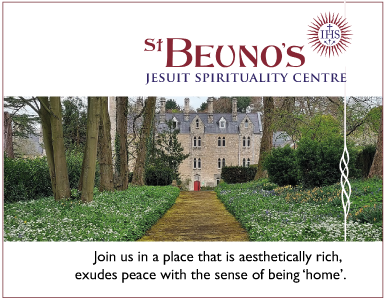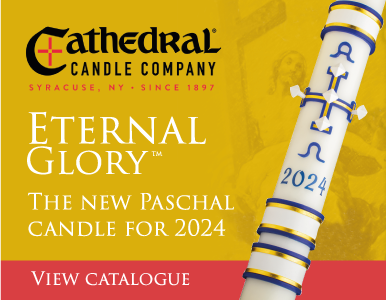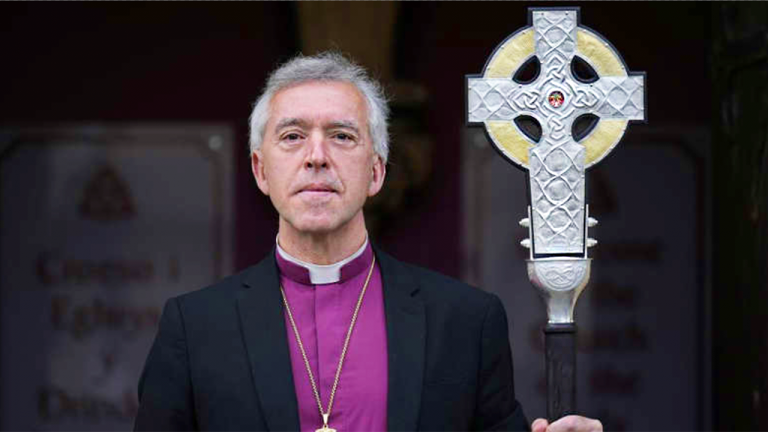Sorry, no records were found. Please adjust your search criteria and try again.
Sorry, unable to load the Maps API.
There was a great deal of excitement around our offices in Llandudno’s Trinity Square this morning, as dignitaries and local townspeople gathered for the formal blessing of the Coronation Cross, also known as The Cross of Wales.
The ceremonial silver cross containing shards said to be from the cross used to crucify Jesus was blessed in Holy Trinity Church by the Anglican Archbishop of Wales, Andrew John, ahead of its journey down to London, where it will be carried at the head of the coronation procession of King Charles III. The Cross of Wales will be seen around the world by millions as it is carried solemly into Westminster Abbey on 6th May.
Designer Michael Lloyd took two years to make the Cross of Wales, involving more than 217,000 hammer blows to chase out its design. Crafted from recycled silver bullion provided by the Royal Mint in Llantrisant, South Wales, the cross includes a shaft of Welsh windfall timber and a stand of Welsh slate, but its centrepiece is two shards of the True Cross which were given to Charles personally by Pope Francis to mark the royal occasion.
Both pieces are shaped as crosses, one being 1cm in size and the other 5mm, and are set into the larger silver cross behind a rose crystal gemstone so they can only be viewed up close.
Words from the last sermon of St David are inscribed on the back of the cross in Welsh, which read: “Byddwch lawen. Cadwch y ffydd. Gwnewch y Pethau Bychain”, translated as: “Be joyful. Keep the faith. Do the little things.”
During the service Archbishop Andrew said: “May this cross be sanctified that whoever prays before it in your honour, may find health and wholeness for body and soul, through the same Jesus Christ our Lord.”
The Cross of Wales was a gift from Charles to the Church in Wales to mark its centenary but, rather unusually, after the coronation it won’t be locked in a royal exhibition somewhere but will be returned to Wales, where it is going to be shared by both the Anglican and Catholic churches for ceremonial occasions.
Archbishop Andrew said: “We are honoured that His Majesty has chosen to mark our centenary with a cross that is both beautiful and symbolic. Its design speaks to our Christian faith, our heritage, our resources and our commitment to sustainability.”
His comments were echoed by the Catholic Archbishop of Cardiff and Bishop of Menevia, Most Reverend Mark O’Toole, who said: “With a sense of deep joy we embrace this cross, kindly given by King Charles, and containing a relic of the True Cross, generously gifted by the Holy See.
“It is not only a sign of the deep Christian roots of our nation but will, I am sure, encourage us all to model our lives on the love given by our Saviour, Jesus Christ.
“We look forward to honouring it, not only in the various celebrations that are planned, but also in the dignified setting in which it will find a permanent home.”
The event certainly captured plenty of media mileage this morning, and made an uplifting change from the increasing flow of negative announcements and news stories surrounding a coronation that was always going to be on a controversial knife edge, even before global economics and shifting social attitudes came in to play.
Gifting a foreign royal a relic of such profound significance was clearly a measure of the importance that Pope Francis attaches to the British monarchy, even if there seem to be enough shards of the True Cross around to build a fleet of battleships. For Charles, placing a personal gift from the head of the Roman Catholic Church at the very centre of the coronation has been read as a clear marker of his determination to bring other faiths into the proceedings.
And if my dear mother is to be believed, it’s also yet more evidence that the British Royal family is – and has long been – covertly Roman Catholic.
The mood around Llandudno this morning also reflected other complexities – for some the Cross of Wales is a concise, modern and appropriately symbolic representation of everything that’s best about Wales, and bears with it aspirations for even closer unions between Welsh Catholics and Anglicanism. For others it epitomises the whole problem of the subjugation of Wales, and in particular brings back memories for some north Walians of the controversies surrounding the investiture of Charles as Prince of Wales (at nearby Caernarfon Castle on in July 1969) – an event which gave rise to a whole radical movement towards Welsh national independence. Out of that turbulence and contradictions came the Welsh Assembly, and Wales today is closer to full independence that most of those early activists could ever have dreamed or imagined.
As such, initiatives encouraging unity between faiths in Wales can only be to the good, but not so deference to a monarchy that has always fought hard to retain its control of what it sees as a subservient principality.
It’s not known whether Pope Francis was aware that his gift of the True Cross was going to end up encased in an historic coronation artefact, but one might fairly assume that he did, as such politically-charged gestures rarely take place without consultation.
In some ways today’s news rectifies an omission of his predecessor – when Benedict XVI came to the UK in 2010 he arrived in Scotland where he met the Queen and other dignitaries at Holyrood, toured the streets of Edinburgh and celebrated a open air Mass at Glasgow’s Bellahouston Park, after which he tracked down to London for a whirlwind series of events, before heading back up to Birmingham to oversee the Newman beatification and final Mass of the tour. However, despite the best efforts (and to the severe disappointment) of all involved in the pre-planning, it was deemed that Benedict was physically not up to visiting Wales – unlike John Paul II who had flown in so triumphantly to Cardiff during his historic 1982 visit to the UK.
Whilst many in Wales will look to the Coronation Cross with mixed emotions, if you’re into symbolism it’s worth remembering that the subliminal traffic here is travelling away from subjugation – it is the symbolism of Wales and Welshness that’s heading up the king’s coronation, and the Cross will be returning to Wales. More importantly, Pope Francis’ relic of the True Cross will bring to Wales an object of communal Christian veneration as sacred as the Nanteos Cup, the Cross of Neith (also both once said to be relics of the True Cross) or the finger bone of St Winefride.
But whatever political and cultural symbolism becomes attached to this exquisite object, Archbishop O’Toole of Cardiff is right when he says it will forever serve as a reminder of “the love given by our Saviour”.
Joseph Kelly is a Catholic writer and political theologian




































